100M
The first man to cross the line in the 2021 European U20 decathlon was Sweden’s Jacob Thelander in a huge PB of 11.09 in Heat 1 of the 100m, taking 0.31 seconds off his previous best. Germany’s Roman Jocher looked great as he sped to 11.56, also a lifetime best, but sadly he was to injure himself in the long jump and retire from competition.
Among the pre-competition favourites, Sander Skotheim of Norway ran 11.31 in Heat 2, while Belgium’s Jente Hauttekeete and France’s Téo Bastien both ran 10.97 in Heat 3. The fastest overall was Czech Republic’s František Doubek in 10.94.

Germany’s Till Steinforth and the Netherlands’ Gabriel Emmanuel both ran under 11 seconds for the first time in 10.97 and 10.98 respectively, while Ireland’s Diarmuid O’Connor reduced his lifetime best by a further 2 hundredths from his competition in Arona a month ago.
After 1 event:
- 1. Doubek 874
- 2. Bastien 867
- 2. Hauttekeete 867
- 2. Steinforth 867
- 5. Emmanuel 865
LONG JUMP
Like the equivalent competition in the women’s U20 heptathlon the previous day, the winds were erratic across the neighbouring runways, varying from +4m per second in Rasmus Roosleht’s final jump in Group B – unfortunately the third foul for the Estonian – to -1.7 in Téo Bastien’s first round jump in Group A. There were also some technical issues in Group B, with the first few jumps in the first round scratched, and everyone invited to retake their initial jumps.
Till Steinforth, very much emulating the performance of teammate Nils Laserich the previous weekend, had a roaring long jump, and his 7.67 in the third round was the longest of the day, benefitting from a +2.2 wind. Four men surpassed 7m for the first time in this competition: Gabriel Emmanuel (7.01), Diarmuid O’Connor (7.01), Jose San Pastor of Spain (7.05) and a huge 7.35 for Ville Toivonen of Finland.

The wind changed to help Téo Bastien to a third-round jump of 7.20, and František Doubek equalled his lifetime best of 7.24 in the second round.
Sander Skotheim had a solid jump of 7.06 in the first round, before leaping to a 16cm PB of 7.55 in round 2. Jente Hauttekeete similarly had a safe 7.12 in the first round, but he responded to Skotheim’s big jump, and after an age waiting for a white flag, his third-round jump was measured at 7.44.
After 2 events:
- Steinforth 1844
- Hauttekeete 1787
- Doubek 1745
- Skotheim 1740
- Bastien 1729
SHOT
The third event is the specialist domain of Spain’s Jose San Pastor, who is in his first season as a decathlete after previously competing in the shot and discus. So, it was no surprise that he threw the furthest, and over 16m twice: 16.16 and 16.19 in the first two rounds. The next longest was a monster throw from Finland’s Aleksi Savolainen with 15.46, adding 66cm to his previous best.

Unlike in Arona, when he was on two fouls until the final round, Jente Hauttekeete got a big throw in early, a solid 15.31 in the first round. Sander Skotheim was similarly strong, improving in each round from 13.69 to 14.21 and finally to 14.63. Doubek’s best was 14.26 in the third round, while Téo Bastien added 50cm to his PB with 13.78, and Gabriel Emmanuel set his 3rd lifetime best in 3 events with 14.50.
After 3 events:
- Hauttekeete 2596
- Skotheim 2507
- Doubek 2489
- Steinforth 2481
- San Pastor 2471
HIGH JUMP
The big jumpers in the competition were the two favourites, Skotheim and Hauttekeete, Sander’s PB just 2cm ahead of Jente’s, 2.12 to 2.10. Both men entered the competition safely at 1.91m. That was also the best height that František Doubek achieved, just a little short of his lifetime best of 1.95. So far, so good.
Onto 1.94, at which both Jente and Sander passed. Téo Bastien entered at the height, and cleared, as did Thibaut Giroire of France, Alessandro Sion of Italy and Jacob Thelander, who had a streak of beautiful first-time clearances during the competition.
Then 1.97 and Bastien cleared first. Hauttekeete cleared next. Thelander and Sion followed, joined by Norway’s Abraham Vogelsang at the third attempt. Skotheim was last to jump and was on two failures. Was the man with the best high jump in the competition about to go out before he got to 2m? Skotheim approached the bar, but to no avail, and he went out at 1.97. Unfortunately, having passed at 1.94, his best height was only 1.91. Hauttekeete went onto clear 2.00m, 2.03, 2.06 and 2.09 and in the process gained 160 unexpected points on Skotheim.
Meanwhile in Group B, several athletes were having the competition of their lives. Jose San Pastor equalled his personal best of 1.85. Aleksi Savolainen improved his lifetime best of 1.86 to 1.88 and then 1.91. But Till Steinforth was on fire. He started the competition with a PB of 1.88, and cleared not only that, but 1.91, 1.94 and 1.97 before retiring, adding 9cm to his lifetime best overall. And Diarmuid O’Connor had a cracker too – he cleared every height at the first attempt all the way up to new PB heights of 1.97 and 2.00, and he was really close at 2.03.
Steinforth climbed back into second place, with Bastien, Skotheim and Doubek close behind, while Hauttekeete stretched ahead by over 200 points.

“The high jump was pretty intense,” said Till afterwards. “This year I struggled a bit with the high jump early in the season and just jumped 1.84 so now jumping 1.97 was huge for me. I watched both Nils Laserich and Andi doing the decathlon – they both had great results, so I’m looking forward to a nice second day.”
After 4 events:
- Hauttekeete 3483
- Steinforth 3257
- Bastien 3247
- Skotheim 3230
- Doubek 3212
400M
Last event of the day, and Sander Skotheim came out absolutely fighting after a low par – for him – high jump. He, along with Doubek, was the fastest of all the athletes coming into the competition with a lifetime best on 49.00. Skotheim ran 49.05 to finish first in the final heat but he wasn’t the first across the line. Doubek got there first, but was disqualified for a lane violation, as was Jose San Pastor in Heat 1 and Belgium’s Jef Misplon in Heat 2. That shook things up, as Doubek was a medal contender, and Pastor was having a great competition with several PBs already under his belt.
However, it wasn’t the only drama, as Hauttekeete yet again gained an advantage in an event in which Skotheim was – before this weekend – much stronger. Jente improved his 400m PB by almost a second to break 50 seconds for the first time, running 49.07 to finish just 2 hundredths of a second – and one single point – behind Skotheim.
O’Connor also had a big improvement, taking almost half a second off his best to run 49.12 behind the Norwegian and Belgian. It was his 4th PB, and like Hauttekeete and San Pastor, he had continued his improvement from Arona a few weeks earlier.
“Four PBs! I can’t believe it, “Diarmuid reflected at the end of Day 1. “The guys got past me early in the 400 but in that last 100 I think I just had a bit more left, and I was able to make it up. It’s been an amazing day. Arona was a really stressful weekend, because I had a lot of last attempts, pulling it out of the bag. I got sick for about a week afterwards, and then I only had two weeks of training for this. But I think that was good too, to restrict myself and not push too hard before the championships.”
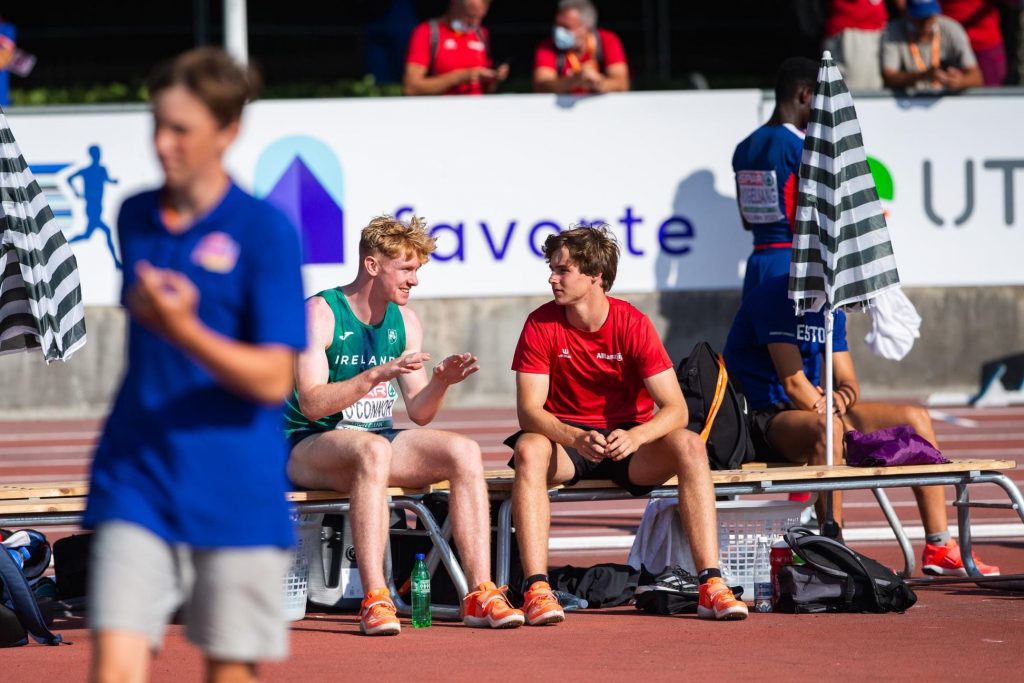
In Arona, Hauttekeete had been on 4257 points at the end of Day 1 when he was en route to 8034. He was already 84 points ahead of that in Tallinn, and importantly 252 points ahead of Skotheim. Behind Skotheim, it was close between Bastien, Steinforth and O’Connor.
After Day 1:
- Hauttekeete 4341
- Skotheim 4089
- Bastien 4055
- Steinforth 4027
- O’Connor 4006
110mH
Despite their misfortune in the 400m the night before, Doubek, San Pastor and Misplon all came out to start day 2, and Jose managed a lifetime best of 14.70 in the second heat, despite kicking a hurdle on the way. However, sadly Switzerland’s Yves Baur joined the ranks of those who would score from fewer than 10 events, hitting the first hurdle and crashing out of the race. Hauttekeete was the fastest, running 14.09, his best in a decathlon and not too far away from his outright best of 14.02. Behind him a stream of men had great runs: Till Steinforth in a 14.19 PB, Abraham Vogelsang in a 14.31 PB, Diarmuid O’Connor with yet another PB of 14.36, and Alessandro Sion in 14.39. Skotheim ran a solid 14.54 in the first heat.
After hurdles:
- 1. Hauttekeete 5304
- 2. Skotheim 4995
- 3. Bastien 4977
- 3. Steinforth 4977
- 5. O’Connor 4935
DISCUS
Group B competed first and after a strong first day, Jacob Thelander carried his momentum into Day 2 where he exceeded his old discus PB of 40.35 twice, once in the first round with 43.58 and again in the third round with 44.20. Diarmuid O’Connor is getting closer and closer to 40m, throwing a 2m PB of 39.73 in the second round. Tony Tamm of Estonia also had a good discipline, extending his 40.96 lifetime best twice to 42.06 and then 42.95. Till Steinforth’s best was 35.89.
An hour later, Group A took to the circle and with his very first throw Téo Bastien set the tone. He threw 47.32, a lifetime best by over 2m and the best throw of the entire competition. Jose San Pastor continued to compete like nothing had happened in the 400m and was over 45m for all three of his throws, including a PB. And Alessandro Sion also had a great discipline, with a best throw of 44.60 in the first round to go over 44m for the first time.
Unlike the hurdles where Hauttekeete had the advantage on Skotheim, it is the other way around for the discus (and pole vault, and javelin) where the Norwegian is the stronger. Both threw solidly, Sander 44.85 and Hauttekeete 43.69, but the Belgian continued to max out his weaker events and constrain Skotheim’s ability to catch up.
After the discus was completed Bastien had moved, briefly, ahead of Skotheim. But a real tussle was developing in 4th, 5th and 6th place as O’Connor, Steinforth and Thelander were separated by just over 80 points.
After 7 events
- Hauttekeete 6044
- Bastien 5792
- Skotheim 5759
- O’Connor 5594
- Steinforth 5559
POLE VAULT
No-one no-heighted. Hooray!
It’s always a reason to celebrate when everyone makes it over their opening pole vault height safely and can start climbing to 5m and potentially beyond. On this occasion, although both Sander Skotheim and Denmark’s Nikolaj Grønbech had previously vaulted over 5m, neither quite managed it, although Grønbech came close. Nikolaj had the highest vault of 4.90 but while he had Norwegian company at the height, it wasn’t Skotheim. Instead, it was Skotheim’s teammate Abraham Vogelsang, who cleared 5cm higher than his PB to join the Dane at the top of the event standings. Skotheim’s best height was 4.80, and Hauttekeete two heights behind at 4.60, just one height below his PB.
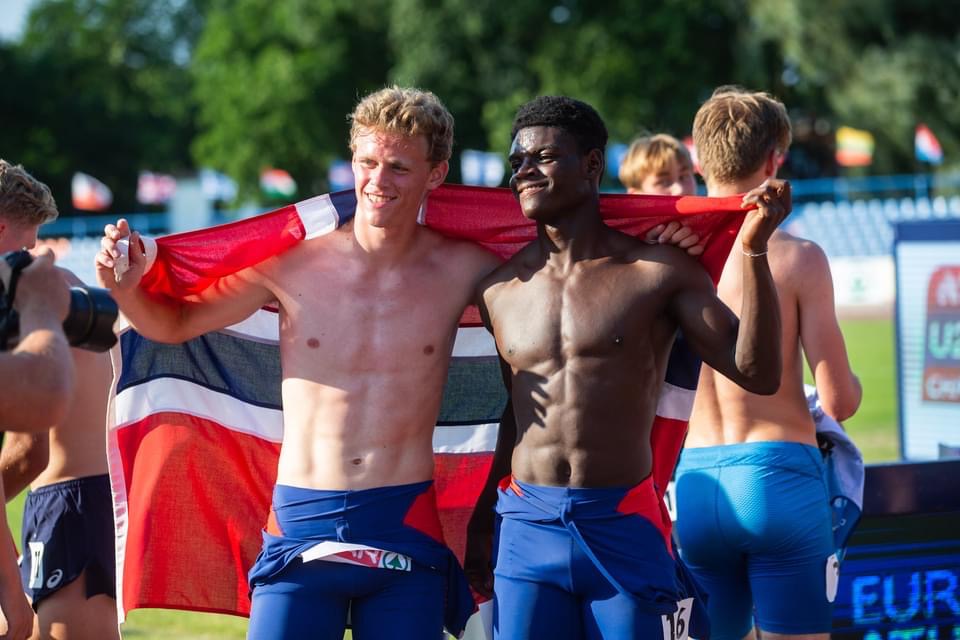
Diarmuid O’Connor and Jacob Thelander continued their sparring match to see who could rack up the most PBs. Thelander equalled his 4.10 best at the third attempt, sailed over a new height of 4.20 at the first attempt, and then 4.30 at his third attempt. O’Connor matched him at 4.20 – his own best from Arona – at the first attempt and then cleared 4.30 also at the first try. But that still wasn’t the most exciting thing happening.
Jose San Pastor, disqualified from the 400m along with Doubek and Misplon the night before, had appeared as a DNS on the start list, with a large bandage covering a gash on his knee. But he changed his mind and decided to continue. Jose’s PB was 4.20, so he started at a modest height, 3.90, which he cleared at the second attempt. He passed 4.00 and cleared 4.10 at the first attempt.
In the middle of all of this, a raincloud arrived over the Kadriorg stadium and emptied its contents, halting competition for a short while.

Competition resumed and San Pastor continued, attempting 4.30. He made it at his second attempt, securing his first PB of the discipline. As Thelander and O’Connor reached their limits, he continued alongside Tony Tamm, the best of the vaulters in the group with a lifetime best of 4.60. Tamm cleared 4.40 at the first attempt. So did San Pastor. Another PB for the injured Spaniard. Onto 4.50. They both failed at their first attempt. Tamm was first in the jumping order, and took his second attempt, which he also failed. Jose took his second attempt. And he was clear! Tamm couldn’t make it over and so San Pastor finished top of the group, with three PBs in an event in which he hadn’t even intended to participate.
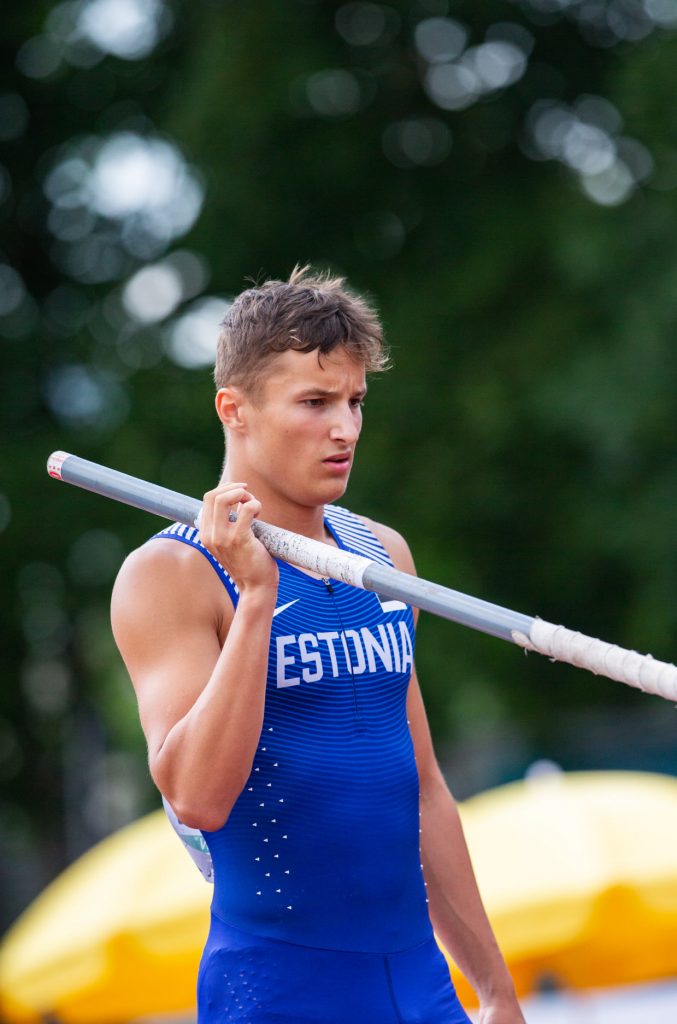
Back at the top of the standings, Skotheim had pulled back almost 60 points on Hauttekeete and moved back into second. Two hundred and twenty-six points now separated them; and going into the javelin, Skotheim’s best javelin was 128 points better than Hauttekeete’s. The competition wasn’t over yet.
After pole vault:
- Hauttekeete 6834
- Skotheim 6608
- Bastien 6523
- O’Connor 6296
- Vogelsang 6262
JAVELIN
The era of Niklas Kaul has brought with it a new focus on the javelin as the event which can change everything. That wasn’t quite the case in Tallinn, but it was significant nonetheless.
Group B was first to go, and as with Saga Vanninen in the heptathlon, we were treated to some super Finnish javelin skills. Ville Toivonen, over 68m at his best, threw 65.56 in the final round which moved him from 8th to 4th place overall.
An hour later, it was time for Group A. The leader Hauttekeete was first to throw, and Jente opened with a good 51.50, just a metre below his PB. A few throws later Nikolaj Grønbech threw the first of his two lifetime bests, 58.15 and then 59.02 in the third round. Skotheim was consistent around the 56m mark, with 55.98, 56.96 and 55.82. However, yet again Jente was able to close the gap to Sander in one of his weaker events, as the Belgian threw a PB of 54.28 in the second round.






Like the pole vault, the action was happening elsewhere, as two men added almost 18m to their combined bests. In the first round, Diarmuid O’Connor threw a massive best of 49.02m, absolutely decimating his previous best of 40.54. And then, like the decathlon equivalent of The Terminator, the injured Jose San Pastor was back, throwing 59.97 to add over 9m to his pre-competition PB of 50.94. What is he going to achieve when he can score from all 10 events!
“Yesterday was a hard “knock-out”,” Jose said later,” but I take that energy to a good shape and make 4 PBs on Day 2, good PBs. The pole vault was crazy – I wanted 4.90 but in the warm-up I fell out onto the box. But 4.60, it’s a very good mark. The javelin for me was very unexpected because in training it was difficult to get over 40m, because of some technical problems. But the stadium with the public and everything together let me make that mark and so I’m really grateful.”
As the final event loomed, Jente still had a healthy lead of 186 points over Sander, and Téo had a buffer of almost 200 points in third.
But attention then turned to points. With his big javelin throw, Jente was on for 8200, and potentially even Markus Rooth’s all time No.2 score of 8238. Rooth had predicted the previous weekend that his mark could go. What could the Belgian do?
1500m
Jente needed a time of 4:28 to beat Rooth’s score, some 8 seconds faster than his 3:36 PB. His teammate Jef Misplon, with a PB of 4:24, was lined up to pace him.
It’s worth noting that that in 2019, World Athletics decided that a new approach would be piloted at the World U20 Championships in Nairobi in the combined events, using the Gundersen method. That approach means that athletes have a staggered start in the 1500m according to how many points they are ahead of their rivals. For example, in theory the 186-point gap between Hauttekeete and Skotheim would mean that Jente would start the 1500 some 30 seconds or so ahead of Sander.
Under that approach, it would not have been possible for Misplon, or indeed anyone else, to pace Hauttekeete, since Jef – some 2168 points behind Jente as a result of his 400m DQ – would only have started the 1500 after Jente had finished.
But happily those rules were not in play in Tallinn. Teamwork was possible, and more importantly the athletes who excelled at 1500 got their moment to shine. As in Arona, O’Connor had a thundering 1500m, taking the pace out and finishing second only to Misplon, with 4:31.63 to the Belgian’s 4:31.39. The pair also led Sander Skotheim to a lifetime best of 4:35.03 in the process.

The champion-in-waiting Hauttekeete managed to stay with Misplon for the first few laps, but then fatigue set in and Jente finished in 4:42.62. A score of 8200+ will be for another day – and Jente had said previously that his focus would be the Worlds – but for now Hauttekeete had secured a gold medal, a superb 8150 mark to break his own national record and he slotted in behind the reigning World U20 champion Ash Moloney in 4th on the U20 all time list.
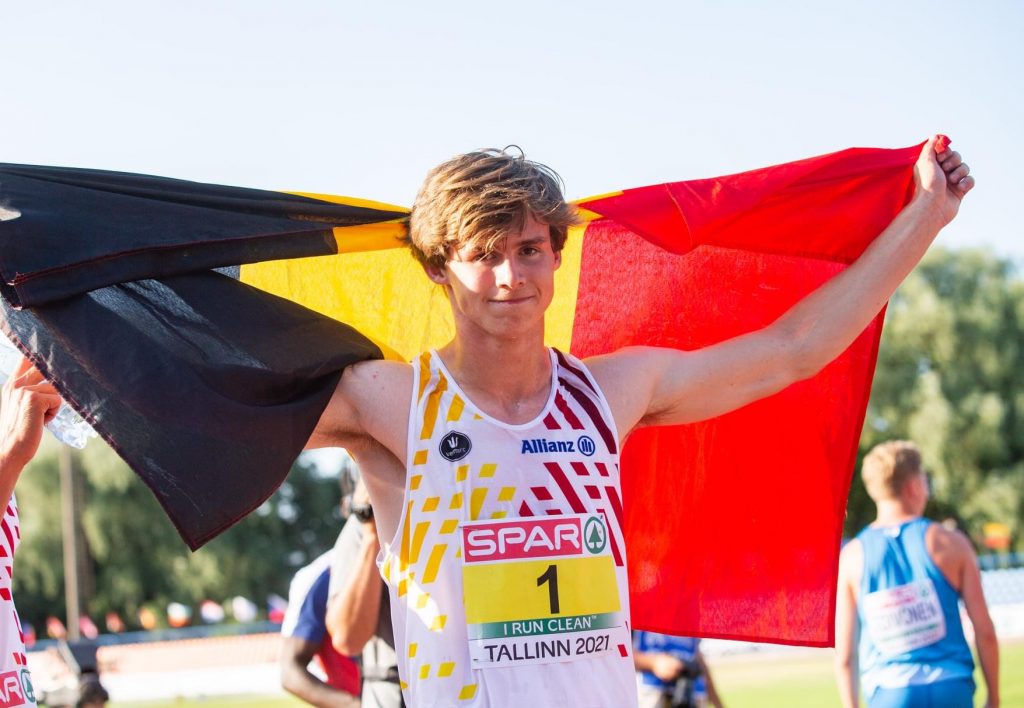
“I’m happy and tired, more happy than tired. My legs are now feeling great now, because of excitement!” Jente said after he received his gold medal. “In Tenerife, the shot put was not good, so now it was 1m and a half better – I think that was the difference between the 8150 I scored today and the 8034 I scored there. Also 400m was one of my worst events, and is now one of my best events. In the javelin I can now also compare with Sander now, he threw 57, I threw 54, only 3 metres difference so I’m very happy. I trained much harder for the 400 and I’m very happy with my time.”
The European U20 champion will also now start as favourite for the World U20s in Nairobi, and Jente intends to build on his experience, as he did after the European U18 Championships in Gyor.
“In Gyor, it was my first international championships and the other guys were older than me. So it was just for the experience But now I was the favourite, I had to wear my name in blue, and that was a lot more motivating for me. And then it changed to yellow. So that was also more motivating. At the end of the first day I had almost 300 points on Sander. I thought in the second day he would get it back, but he didn’t. I know he can do better, and I hope to see him in the following years. Competing together is always fun. We know each other, the bad and the good events – it’s always more mentally rather than physically we compete together.
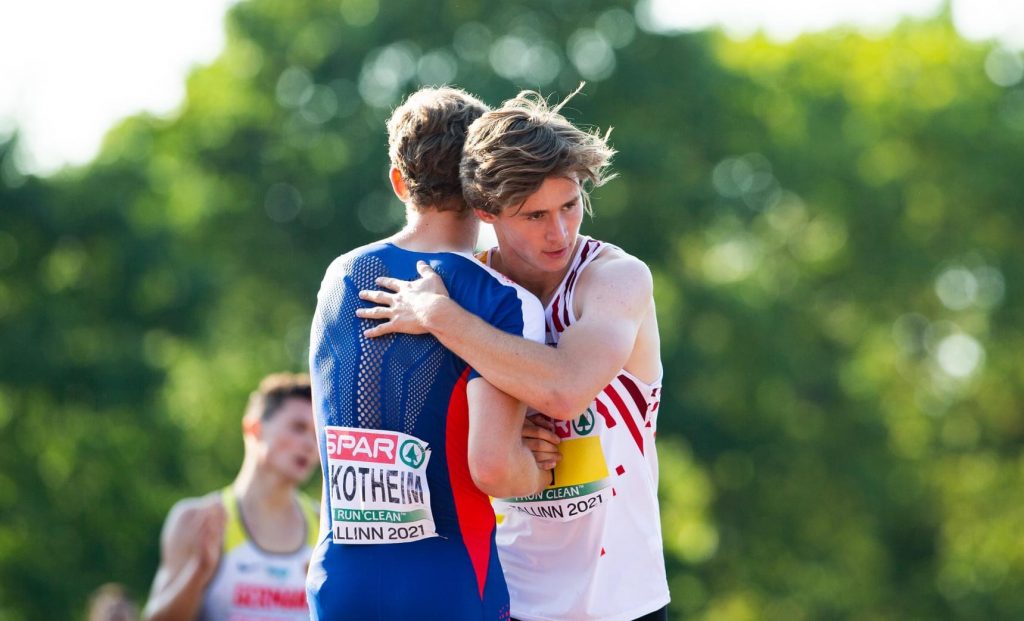
He continued ”I’m taking a full week rest before Nairobi. I think in Nairobi I will be at my best, and I hope to score 8250.”
Which would just leave Niklas Kaul’s world record ahead of him “Yes, but then I have to throw 70m in the javelin!”
Skotheim also broke 8000 points for the first time with 8012 for silver; Téo Bastien set a PB of 7722 in bronze, and Diarmuid O’Connor broke the 34-year-old Irish national record in 4th place with 7604.
“I’m happy and sad”, said Diarmuid after he had extracted himself from the celebrations in the water jump. “It was an unbelievable weekend; I came in here expecting a mid-table performance and I was up there with the top three and I sadly missed out. But that’s what’s going to drive me on for the future. Happy with 8 PBs, I can’t believe that. In the javelin, things just clicked, and I heard a song I liked coming on before and it just got me in the zone. It was for the last lap in the [3000m steeplechase] and it just hyped me up! I’ve learned that I’ve got the capability, and I’ve got the motivation now by missing out on a medal – there’s hopefully going to be a medal in the future to come. At the same time, maybe it would have come too suddenly, and this is the journey it’s supposed to be.”
In 2019 these championships crowned Simon Ehammer, Leon Mak and Markus Rooth as medallists. Two years earlier in 2017 Niklas Kaul, Johannes Erm and Karel Tilga were on the podium, all three of whom are now on their way to the Olympic Games in Tokyo, Kaul with the world title already under his belt. For the young Decathletes of Europe of 2021, the future looks just as bright.
The full results can be found here.
Photos: Javelin gallery Raul Mee, main image Marko Mumm for EKJL.


